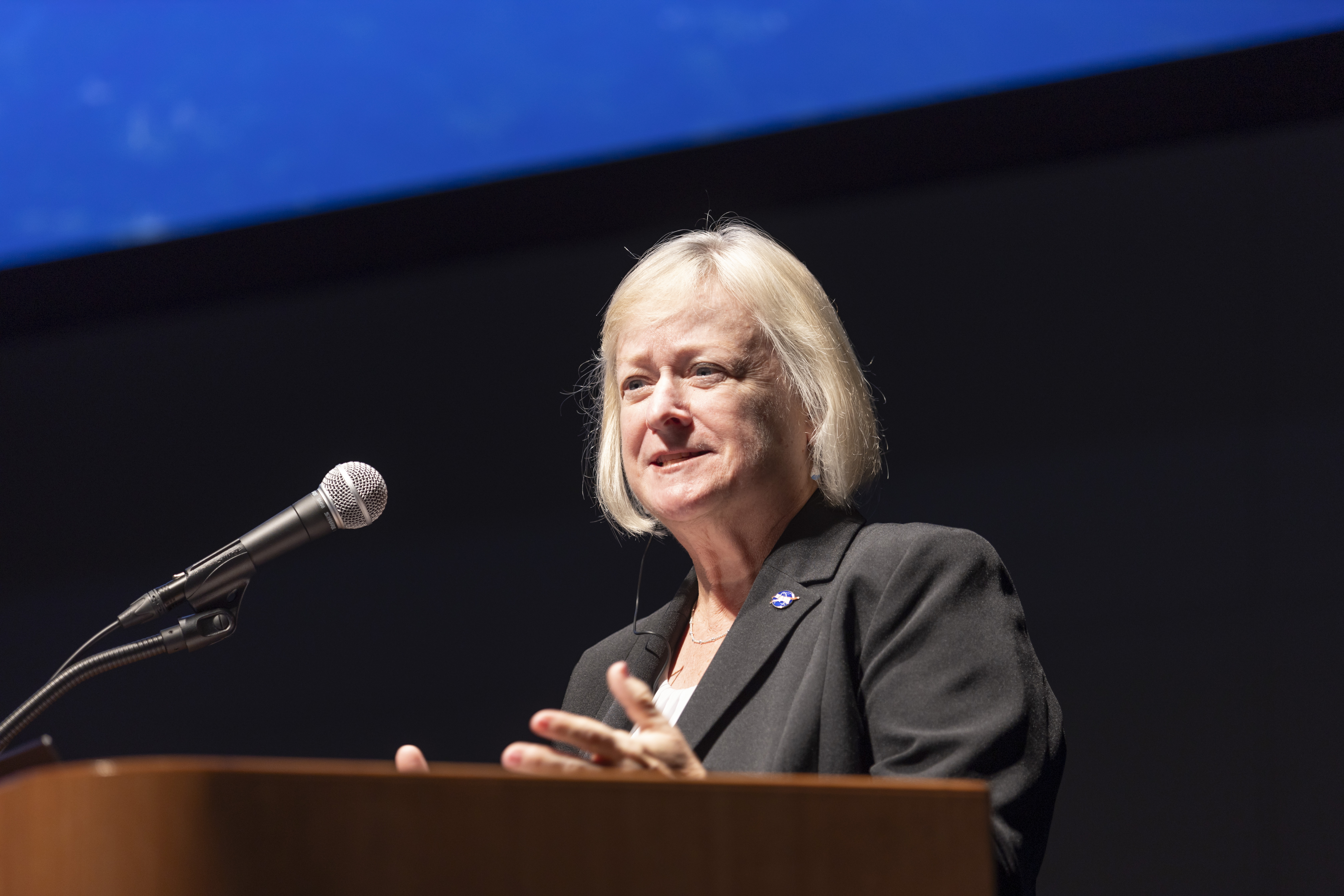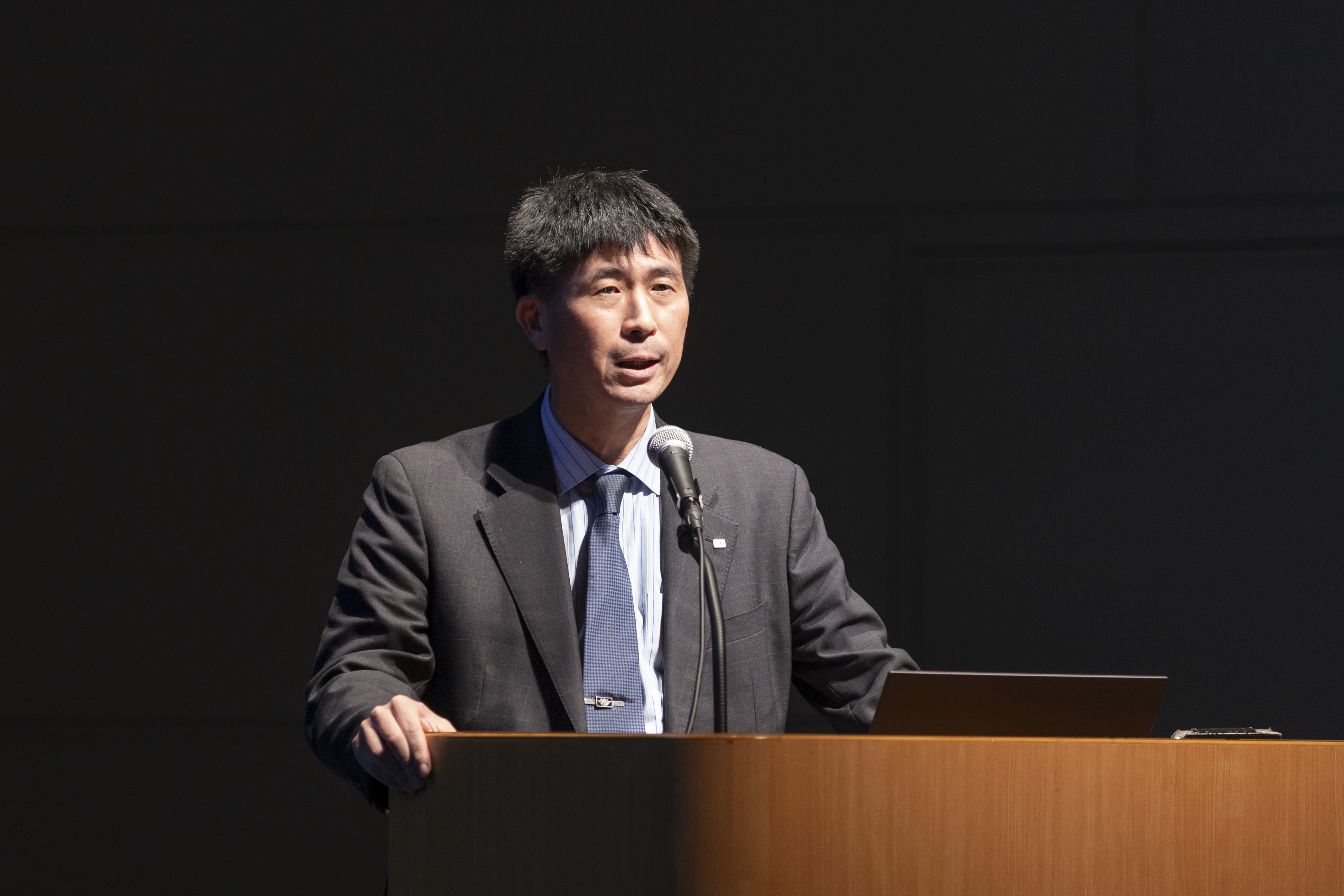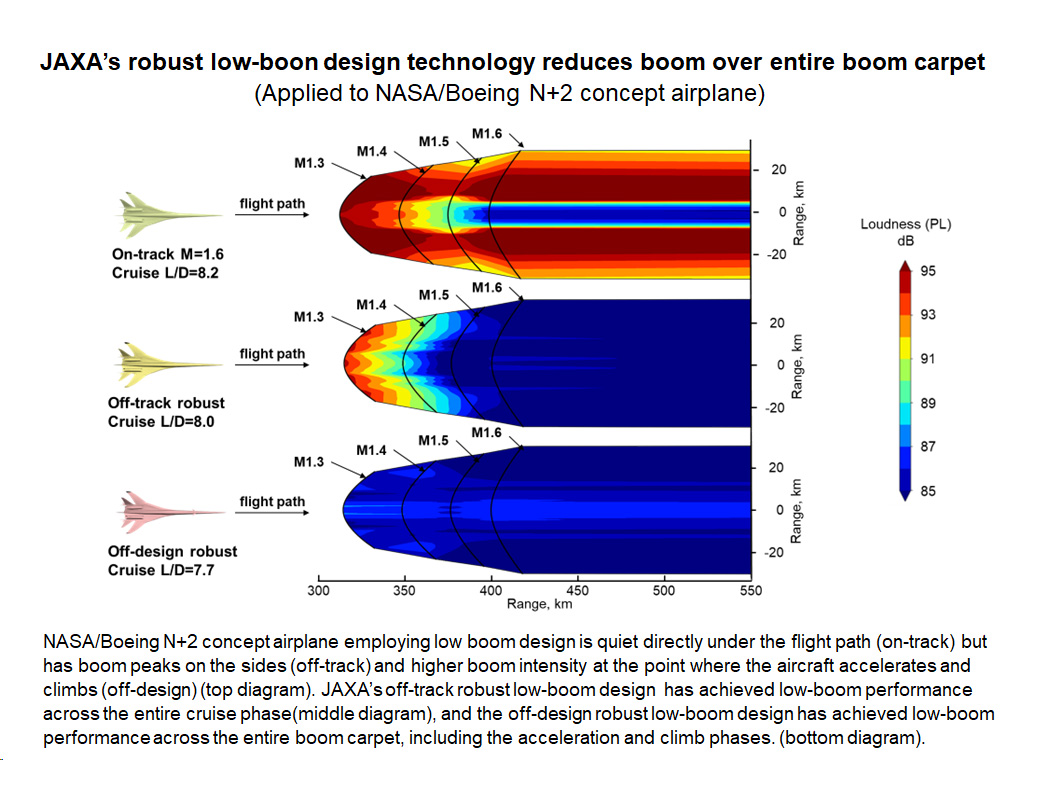Research & Development
JAXA promotes three research and development programs and a fundamental research program that underpins them.
Supersonic transport design technologies
Supersonic Technology Research and International Collaboration: Summary Report from JAXA Aviation Symposium 2024
The JAXA Aviation Symposium 2024 was held on October 18, 2024, in Tokyo, Japan, inviting two special guests from NASA and Boeing. This report provides a summary of two special lectures by NASA and Boeing, which focused on the themes of supersonic technology and international collaboration, along with an introduction to JAXA's new supersonic project, Re-BooT.
[Special Lecture 1]
Quesst: NASA’s Mission for Quiet Supersonic Flight

Carol CARROLL
Deputy Associate Administrator for the Aeronautics Research Mission Directorate
The National Aeronautics and Space Administration (NASA)
NASA’s X-59 research plane, aiming for quiet supersonic aircraft
NASA is nearing the completion of its X-59 experimental aircraft, the centerpiece of its Quiet Super Sonic Technology (Quesst) mission to achieve quiet supersonic flight.
The purpose of the flight is to gather data that will provide regulators with information that could help lift current bans on commercial supersonic flights over land. Such flights have been banned for more than 50 years, because of the loud, disruptive noise produced when the aircraft breaks the speed of sound.
The first flight of the X-59 follows decades of research with international partners, including JAXA and Boeing, into what causes the sonic booms and how they can be mitigated. It has been found that each part of the aircraft -- the nose, canopy, tail and engine inlets -- creates a shock wave travelling at different speeds, and the loud sound occurs when the waves merge. The X-59, with its very long, thin nose and unusual shape on the bottom of the aircraft, does create shock waves, but they do not merge. Therefore, the sound heard on the ground is a much quieter “thump” rather than a sonic boom. NASA wants the sound to be like a car door slamming in a neighbor’s doorway.
NASA and its partners have been engaged in a series of collaborative activities including wind tunnel testing, computational fluid dynamics analysis, and the development of tools to measure sound pressure waves. Throughout the process, the partners share and exchange data.
Of the three phases of the Quesst mission, NASA is now in the first phase of building the aircraft. Phase two is acoustic validation, which involves measuring acoustic pressure waves to verify that the shock waves are as designed.
In phase three, the X-59 will fly over various communities in the U.S. and possibly other countries to collect data, which will be provided to ICAO and its technical committee CAEP to help regulators understand how to revise standards.
Data collection will be broad and extensive, as scientifically valid data is needed for regulators to analyze whether to allow commercial supersonic flights.
Data from 10,000 to 100,000 data points will be collected, depending on the survey method employed, to find out if the sound level is acceptable for people on the ground. NASA hopes to fly the aircraft up to six times a day to ensure enough test time to determine the effects of repeated exposure to the sound.
[Special Lecture 2]
Global Technology & Innovation at Boeing

Dylan JONES
Executive Director
Boeing Research & Technology Japan and Boeing Korea Engineering & Technology Center
Boeing aims to achieve net-zero emissions goals by 2050
Boeing spends more than $3 billion annually on global innovation and has several initiatives underway to achieve its goal of decarbonizing the aerospace industry by 2050.
To achieve this net zero goal, the company has identified four strategies: airline fleet renewal, improving operational efficiency, using renewable energy through SAF, electrification and hydrogen, and deploying advanced aircraft technologies. The company’s 5,000 employee research unit, Boeing Research & Technology (BR&T), is assisting in these efforts through the development of technologies supporting these four strategies.
BR&T opened their Japan Research Center, based in Nagoya, in April 2024, which focuses on technologies for sustainability. Its work includes the use of digital tools for design, the development of lightweight carbon fiber, processes and applications for recycled carbon fiber, and the investigation of the feasibility of hydrogen fuel-cell systems. It also aims to create a thriving SAF ecosystem in Japan.
Boeing is also engaged in various collaborations with JAXA. In addition to the NASA-JAXA-Boeing X-59 collaboration, multiple projects are currently running in partnership with JAXA. The longest of these is the supersonic collaboration, which began in 2006 and consists of four work packages: design, CFD prediction workshops, wind tunnel testing, and practical low-boom demonstration.
It is imperative that the industry develop new types of aircraft and infrastructure based on clean energy sources by 2050, in order to meet the growing demand for global air travel. The Air Transportation Acting Group, an industry group, forecast that by 2050, approximately 70% of the global population will reside in urban areas, with the number of air travelers projected to reach 10 billion annually.
Innovation will be critical to meeting the needs of increased demand and new modes of transportation. Boeing estimates that the industry will require 44,000 additional aircraft over the next two decades.
At present, there is a growing trend toward increased electrification of aircraft. To meet this demand, it is essential to enhance aircraft power capabilities. Boeing is also engaged in the development of hydrogen technology and has tested six distinct hydrogen propulsion demonstrators.
Nevertheless, SAF represents a vital element in near-term decarbonization. For example, a Boeing 787 scheduled for delivery next year will remain in service for 20 years, extending until close to 2050. Boeing values its partnership with Japan and aims to extend it to its next generation of airplanes.
Re-BooT Project

Yoshikazu MAKINO
Manager for Re-BooT Project Team
Aviation Technology Directorate
The Japan Aerospace Exploration Agency (JAXA)
JAXA’s robust low-boom design technology reduces sonic booms across entire boom carpet
JAXA has developed “robust low-boom design technology” to reduce the loud sonic booms generated by supersonic aircraft over a wide area. The technology will be demonstrated in a project called
Re-BooT (Robust en-route sonic-Boom mitigation Technology demonstration).
When an aircraft travels faster than the speed of sound, it creates shock waves that propagate downward over a wide area of the ground, resulting in a sonic boom. Because of the potential community noise issue by sonic booms, overland supersonic passenger flights have been banned for more than half a century.
The U.N.’s International Civil Aviation Organization (ICAO) is discussing the development of an international standard for sonic booms reflecting the growing interest in “quiet” supersonic passenger flights. JAXA, in collaboration with Boeing and NASA, is involved in the discussions to provide technical support.
The ICAO’s discussion will address, among other things, the evaluation of sonic booms and the determination of the appropriate measurement point on the boom carpet, the area on the ground where the shock wave reaches and causes the impact noise.
JAXA has submitted to the ICAO the results of its analysis, which show that JAXA robust low-boom design technology is effective in reducing sonic booms not only directly under the flight path (on-track position), but also in the areas to either side of the flight path (off-track position) and at the point where the aircraft accelerates and climbs (off-design conditions). This indicates that the technology reduces sonic booms over the entire area of the boom carpet, whereas JAXA’s proprietary D-SEND#2 low-boom design technology, which was demonstrated in JAXA’s previous D-SEND project, achieves sonic boom reduction mainly below the flight path (on-track position).
Under the Re-BooT project, which officially began in October, JAXA and Boeing are collaborating on the design of a technical reference aircraft, called Low-Boom Supersonic Technology Concept Aeroplane. This will be achieved by applying JAXA’s robust low-boom design technology to the NASA/Boeing’s N+2 concept aircraft, and the resulting airplane model information will be provided to the ICAO for the standard development process.
Several companies are developing supersonic passenger aircraft. In March, U.S. startup Boom Supersonic conducted the first flight of its XB-1 supersonic demonstrator aircraft. Boom’s planned 65-88-seat airliner named Overture is designed to fly at Mach 1.7, although it is expected to fly at supersonic speed only over the ocean.
The ICAO is expected to propose a sonic boom standard for supersonic aircraft as early as in the 2030s, using data from demonstrations such as Re-BooT and NASA’s Quesst.

December 6, 2024